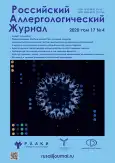Фармакологический профиль антигистаминных средств: фокус на нежелательные лекарственные взаимодействия
- Авторы: Духанин А.С.1
-
Учреждения:
- Российский национальный исследовательский медицинский университет им. Н.И. Пирогова
- Выпуск: Том 17, № 4 (2020)
- Страницы: 46-56
- Раздел: Лекции
- URL: https://bakhtiniada.ru/raj/article/view/121573
- DOI: https://doi.org/10.36691/RJA1407
- ID: 121573
Цитировать
Полный текст
Аннотация
Различия между отдельными антигистаминными препаратами (АГП) определяются такими фармакокинетическими свойствами, как скорость и полнота абсорбции, период полувыведения, участие печеночных и почечных механизмов элиминации из организма. Фармакодинамические особенности антигистаминного средства включают селективность и аффинитет по отношению к Н1-рецепторам гистамина, наличие центральных эффектов. Подробно разбираются механизмы развития нежелательных лекарственных взаимодействий АГП II поколения. Выделено три уровня взаимодействия: 1) печеночные ферменты системы Р450; 2) мембранные переносчики органических анионов (ОАТР) – транспортные белки на синусоидальной (базолатернальной) мембране гепатоцитов и люминальной мембране эпителия проксимального канальца нефрона; 3) Р-гликопротеин (Рgp, ABCB1-белок) эпителиоцитов тонкого кишечника – область абсорбции пероральных форм АГП, эпителий проксимального канальца и гематоэнцефалический барьер. Особое место отведено описанию зависимости фармакологического профиля АГП от их химической структуры. «Эластичность» молекулы биластина, способность к индуцированному изменению конформации, лежит в основе высокой комплементарности биластина к узнающему сайту Н1-рецептора – высокому аффинитету. Экспериментальная оценка подтверждает этот вывод: константа диссоциации (Кд) комплекса биластин-рецептор находится в диапазоне наномолярных концентраций. Молекула биластина как представителя АГП со свойствами цвиттер-иона несет одновременно положительный и отрицательный заряд при физиологическом значении pH, затрудняя его проникновение в мозг. Особенности химической природы молекулы биластина нашли отражение в специфическом фармакологическом профиле АГП. В исследованиях in vitro показана высокая специфическая аффинность биластина к Н1-рецепторам при очень низкой аффинности к другим рецепторам гистамина (Н2, Н3, Н4), серотонина, брадикинина, М-холино- и адренорецепторам. По данному показателю биластин в 3 раза превосходит цетиризин и в 5 раз – фексофенадин. Биластин практически не метаболизируется в организме и экскретируется в основном в неизмененном виде, а также не обладает кардиотоксическим эффектом. Биластин обладает хорошей переносимостью. В терапевтической дозе он обладает менее выраженным седативным потенциалом по сравнению с другими АГП II поколения.
Полный текст
Открыть статью на сайте журналаОб авторах
Александр Сергеевич Духанин
Российский национальный исследовательский медицинский университет им. Н.И. Пирогова
Автор, ответственный за переписку.
Email: das03@rambler.ru
ORCID iD: 0000-0003-2433-7727
профессор кафедры молекулярной фармакологии и радиобиологии, доктор медицинских наук, профессор
Россия, г. МоскваСписок литературы
- Wang X.Y., Lim-Jurado M., Prepageran N., et al. Treatment of allergic rhinitis and urticaria: a review of the newest antihistamine drug bilastine // Ther Clin Risk Manag. 2016. Vol. 12. P. 85–597. doi: 10.2147/TCRM.S105189
- Jáuregui I., Ramaekers J.G., Yanai K., et al. Bilastine: a new antihistamine with an optimal benefit-to-risk ratio for safety during driving // Expert Opin Drug Saf. 2016. Vol. 15. N 1. P. 89–98. doi: 10.1517/14740338.2016.1112786
- Wolthers O.D. Bilastine: a new nonsedating oral H1-antihistamine for treatment of allergic rhinoconjunctivitis and urticaria // Biomed Res Int. 2013. Vol. 2013. P. 626837.doi: 10.1155/2013/626837
- Hu Y., Sieck D.E., Hsu W.H. Why are second-generation H1-antihistamines minimally sedating? // Eur J Pharmacol. 2015. Vol. 765. P. 100–106. doi: 10.1016/j.ejphar.2015.08.016
- Kuna P., Bachert C., Nowacki Z., et al. Efficacy and safety of bilastine 20 mg compared with cetirizine 10 mg and placebo for the symptomatic treatment of seasonal allergic rhinitis: a randomized, double-blind, parallel-group study // Clin Exp Allergy. 2009. Vol. 39. N 3 9. Р. 1338–1347.doi: 10.1111/j.1365-2222.2009.03257.x.
- Kawauchi H., Yanai K., Wang D.Y., et al. Antihistamines for allergic rhinitis treatment from the viewpoint of nonsedative properties // Int J Mol Sci. 2019. Vol. 20. N 1. P. 213.doi: 10.3390/ijms20010213
- Paśko P., Rodacki T., Domagała-Rodacka R., et al. Second generation H1-antihistamines interaction with food and alcohol – a systematic review // Biomed Pharmacother. 2017. Vol. 93. P. 27–39. doi: 10.1016/j.biopha.2017.06.008
- Tiligada E., Ennis M. Histamine pharmacology: from Sir Henry Dale to the 21st century // Br J Pharmacol. 2020. Vol. 177. N 3. P. 469–489. doi: 10.1111/bph.14524
Дополнительные файлы

















